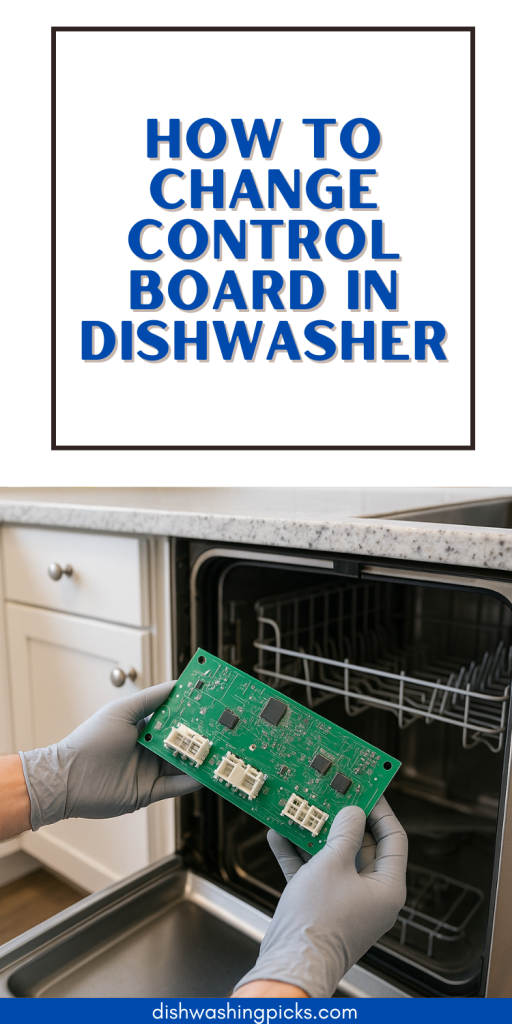
Ever had your dishwasher act up like it’s got a mind of its own? One minute it’s washing perfectly, the next, it’s flashing lights or just refusing to start. Annoying, right? More often than not, the sneaky culprit behind this kitchen chaos is the control board — basically the dishwasher’s brain.
But hey, before you panic and call a pricey repair guy, imagine this: What if you could swap out that faulty control board yourself? No need for wizard-level tech skills or complicated jargon. I’m here to walk you through the whole thing in a way that’s more “friendly neighbor” than “confusing manual.”
So, ready to roll up your sleeves and get that dishwasher back in shape? Let’s break it down, step by step — no stress, just straightforward tips.
What Exactly Is the Control Board, Anyway?
Before jumping in with tools and screws, let’s get on the same page about what this control board actually does. Think of it as the brain of your dishwasher — it controls all the functions like water temperature, cycle timing, and even when to start or stop. So, when your dishwasher starts acting wonky, the control board is often the first suspect.
Imagine trying to bake a cake without the oven timer working properly — the results won’t be pretty. Same deal here: a bad control board can throw everything off.
Signs Your Dishwasher’s Control Board Might Be Toast
How do you know it’s the control board and not something else? Great question! Here are some classic signs:
- Dishwasher won’t start, but you hear a faint hum.
- Buttons or display lights are flashing weirdly.
- Cycles stop halfway or don’t finish at all.
- Dishwasher runs but doesn’t wash properly.
If you’re nodding yes to any of these, your control board might be calling out for some TLC.
Tools and Safety First: What You’ll Need
Okay, so before you get to work, let’s talk tools and safety. You won’t need a full toolbox, but here’s what’s handy:
- Screwdriver (usually Phillips-head)
- Needle-nose pliers
- Replacement control board (make sure it matches your dishwasher model)
- Multimeter (optional, for testing electrical parts)
- Flashlight (because sometimes those kitchen corners get dark)
And of course — safety first! Unplug the dishwasher or turn off the circuit breaker before you start poking around inside.
Step-by-Step: Swapping Out That Control Board
Ready to roll? Here’s how you can do it:
- Unplug or switch off power: No electric shocks, please!
- Pull out the dishwasher: Carefully slide it out from under the counter so you can access the back panel.
- Remove the outer panel: Usually, this means unscrewing a few screws to get to the control board.
- Locate the control board: It’s usually a green circuit board with wires plugged into it.
- Disconnect wires carefully: Take a pic with your phone to remember where each wire goes.
- Unscrew the old board: Then gently pull it out.
- Install the new board: Screw it in place and reconnect all wires as per your pic.
- Reattach the panel and slide dishwasher back.
- Power up and test: Cross your fingers and start a cycle.
And voilà! You just fixed your dishwasher.
Troubleshooting Tips if It Still Acts Up
Not everything goes perfectly on the first try — no worries! If your dishwasher still misbehaves:
- Double-check all wire connections.
- Make sure the replacement board matches your model exactly.
- Test the power supply with a multimeter.
- Consult your dishwasher’s manual or manufacturer support.
Sometimes, the issue might be elsewhere, like a faulty motor or sensor.
DIY Success and Dishwasher Bliss
Changing a dishwasher control board might sound intimidating, but with a bit of patience and these simple steps, you can totally do it yourself. Not only will you save a bundle on repairs, but you’ll feel pretty proud knowing you fixed it with your own two hands.
So next time your dishwasher acts up, remember — you’re the boss here. Ready to give it a try? If you need a hand or have questions, I’m right here.
